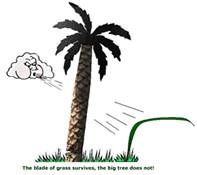The Big Tree and the Blade of Grass
Devdas Menon
Text of an article that appeared in the December 2005 edition of the IIT Madras magazine Reflections
Consider a big tree with a stout stem, and standing next to it, a slender longish blade of grass. Which of the two is more likely to survive a severe storm? The students attending a class on Structural Analysis try to visualise the scenario, and soon come up with the right answer. The blade of grass, of course. The next logical question Why so? takes a while and some discussion, before the answer emerges. Because the tree is relatively rigid and the blade of grass flexible. The rigid tree refuses to bend easily, and this resistance introduces stresses, which keep building up as the wind load increases. The tree's resisting capacity has a limit, of course, and a severe storm can knock the tree down. The blade of grass, on the other hand, gives way from the very start, bending over backwards, and so hardly offering any resistance to the load. When the storm gets over, it bounces back to its original configuration. Interesting behaviour, especially when one begins to realise that this phenomenon also applies in many situations to human beings.
The students are quick to grasp this, and our discussion then moves on to explore: What is ideal: to be rigid or to be flexible? There is much debate, and perhaps there is a sense of unease in discovering that there are no absolute 'right' answers to this one. We find ourselves in noble company, of course, when we note that even brave warriors like the legendary Arjuna had serious problems on this very question, and that too in the middle of a battlefield. We humans mostly like to have security and certainty in our lives, and it is disconcerting when we find ourselves confused. Many of us look for authorities and dogmas to tell us what to do, and even when clear-cut instructions are available (which is not always the case), we often end up doing the 'wrong' things, driven by our own unconscious tendencies. We are then beset with doubts and feelings of guilt after the deed is done.

God, grant me the serenity to accept the things I cannot change, the courage to change the things I can, and the wisdom to know the difference is the beautiful 'serenity prayer' that expresses this sentiment. The emphasis in this prayer is, interestingly, on serenity, acceptance and courageousness. There is no mention of resistance.
But it is resistance that is our second nature! We tend to resist almost everything that does not conform to our likes and beliefs. When people 'misbehave' or things that we dislike happen, we find inner resistance building up. We are like the big tree. This inner resistance may be expressed outwardly or may be suppressed, depending on our habitual inclinations. Either way, our reactivity takes away our serenity and makes life difficult not only for us but also others around us.
Invariably, we believe that the cause lies outside us and our reactivity is an effect that is 'natural' and hence justifiable. There is a habitual pattern to this cause-and-effect behaviour, which we can discover if we allow ourselves to look inwards with detachment. We then notice a set of resistance patterns in us. These patterns seem to suggest that cause and effect are perhaps inextricably linked to each other. It is as though, because of our innate resistance, we attract magnetically certain kinds of 'loads', which in turn induce 'stresses' that in turn serve to strengthen our resistance and our beliefs about the external cause, in a seemingly endless cycle.
The mere witnessing of this process - which means making conscious our unconscious behaviour patterns - can help us break out of this vicious cycle. Instead of running on 'automatic', which is all-too-common, we discover a whole range of creative possibilities of dealing with every situation in life. Of course, the difficult thing is to allow witnessing, but this can be discovered through meditative practice and continued self-awareness. First, we must learn to find serenity in the absence of any storm, in our day-to-day living. Then, we can discover ways of dealing with the small storms, and then with big ones. Most of the storms lose their power to hurt us when we realise that they are imaginary. It is often like pricking an inflated balloon.
There is much to learn from the little blade of grass. Insignificant in comparison to the mighty tree, it is the blade of grass, acting without resistance that survives the severe storm.